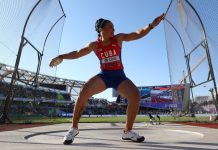Disclaimer: Content herein does not constitute specific advice to the reader’s circumstance. It is only an opinion based on my perspective that others may learn from.
Anyone of any age who engages in running should be in tune with their body and seek medical advice before embarking on any intensive activity (including changes to said activity) that may unduly extend them. This is critical should the aspiring athlete have underlying medical conditions and/or ongoing health issues requiring medication.
In my first article I described 5 main principles for training of the mature elite competitive runner as Consistency, Quality, Strength, Supplementary Exercises, and Active Rest. Having covered the principles of Consistency and Quality in Parts 1 and 2, today’s article is about Strength. I should disclose that I have used some revised content of an article I wrote nine years ago, with the inclusion of recent learnings. I wish to emphasise that I am definitely not an expert in strength training and the content of this article reflects my personal views based purely on my reading of this issue and my limited practical experience.
Over many years I have come to the view that free weights training provides the best strength development outcomes for distance runners. Therefore my article centres primarily on this aspect of strength training, with peripheral reference to other types of strength based work. I have tried to limit overly technical commentary of what is a highly complex field.
My intention is to stimulate mature runners to thoroughly investigate the best mix of strength training for their circumstance. Certainly, any mature competitive runner who denies the relevance of strength training to achieve their best possible racing performances has their head in the sand.
Hill training will be covered in a separate article.
My strapline of just enough is good enough reflects the need to adopt an approach to strength development that fits within a broader training program, without overdoing it. Note that strength training is in addition to other training within your program. It is not a form of cross training, which by definition means replacing one form of exercise with another, for example cycling for running. The question is how to integrate and manage strength training within a program that is targeted specifically to distance running performance for the mature competitor.
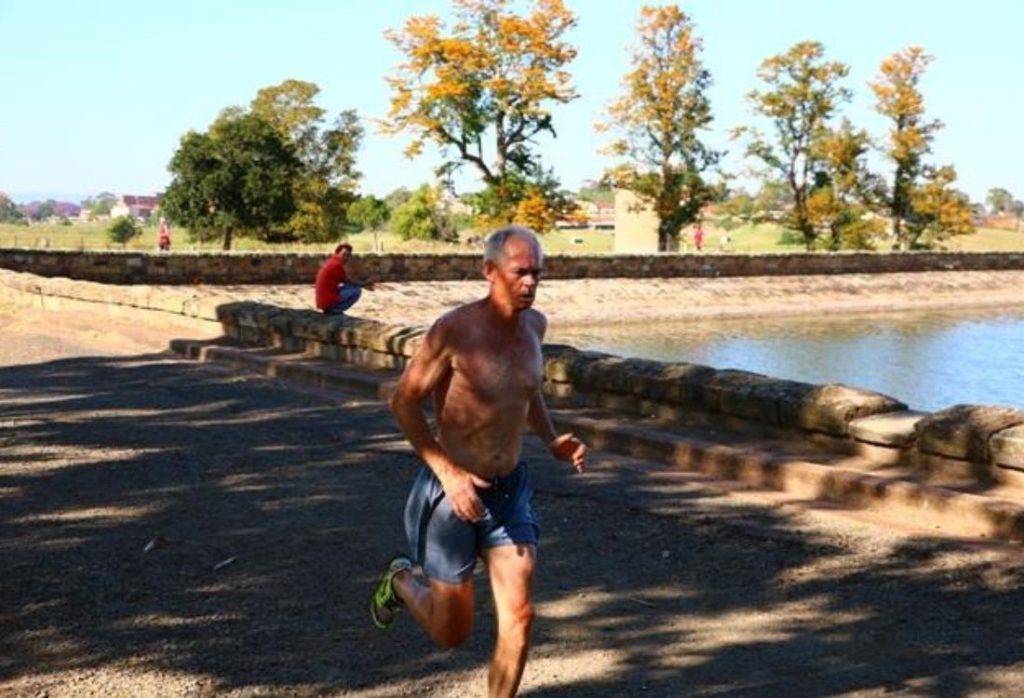
- What is Strength?
Strength can be defined as the ability to exert force (measured in Newtons) to overcome resistance, and can be developed by lifting a low number of free weights at greater than 85% of your 1 rep maximum. Strength training efforts lead to a higher recruitment and stronger synchronisation of muscle fibres. Strength is different to power. Power (measured in Watts) is the ability to exert force in the shortest period of time, and can be developed by lifting a higher number of free weights at up to 70% of your 1 rep maximum. (1)(2)
For the general population, as we age muscle power decreases at a greater rate than strength. So for a non-sportsperson exercises that generate gains in power become especially important later in life. Of note, physiotherapists assisting the aged now combine the high-velocity moves of power training with more deliberate and slow strength-training exercises to reap the benefits of both activities. (3)
- Basic Tenets
It has long been argued that weight training (for upper and lower body) results in improvements in running economy and a greater capacity to exercise to exhaustion, along with improved neuromuscular coordination, and ultimately a higher anaerobic performance. Upper body development can also improve running posture, respiratory efficiency and resistance to arm fatigue over longer distances. (4)(5)(6)
The views expressed by Cerutty and Lydiard are central to my personal approach. Their writings on conditioning, resistance and strength training stand the test of time. Though they have differing opinions about weight training, inherent within their perspectives is support for whole of body strengthening. I agree with Cerutty about the use of heavy free weights as the optimal form of strength training for all distance runners, not just the middle distance cohort. Lydiard, was concerned about risk of injury and whether use of weights is the most efficient use of training time. Therefore, his programs concentrate on strength development primarily through a range of hill work.
Cerutty was scathing in his criticism of proponents of light weights/high repetitions, preferring heavy weights/low reps that build ‘light steely muscles rather than bulky, weighty ones.’(7) In more scientific terms Livingstone advises that ‘Very heavy lifting (above 85% of your 1 rep maximum) with few repetitions, in a few sets, with plenty of recovery between sets, will primarily recruit and train the fast twitch fibres and their huge incoming neural pathways’ as long as total load or lifting time is within 10 seconds or less (the alactic time zone). (8) Speed of lift, aka movement velocity, is slow because the weight is heavy. (9) Such an approach prevents the development of unwanted muscle characterised by bulking up.
Arguments still rage about this point of view, some discounting whether there is a net benefit to racing performance by lifting heavy weights. However, based on my own experience I have no doubt about the value of heavy weights for mature competitors. I also note that a body of contemporary research contends that working with free weights gives the best strength development outcomes.

- Why is Strength training important for the experienced mature competitor?
Friel cites two reasons for conducting high load strength training year round. Firstly, research has shown a discernible improvement in performance in endurance sports for women and men. Secondly, it has the potential to slow the reduction of muscle mass caused by atrophy that is associated with aging. Lifting weights increases the production of muscle building hormones such as growth hormone, testosterone and insulin like growth factor. (10)
Muscle mass declines at a rate of 8% every 10 years from the age of 25-30 years onwards. There is a concurrent loss of bone mass at a rate of 1% per year from age 35. (11) The consequent loss of muscle strength and bone density becomes a matter of health and wellbeing, affecting a person’s quality of life and increasing the risk of injury. Given this outlook it makes sense for the mature competitor to conduct strength training all year round as a beneficial aid to running performance and to reduce the risk of injury from weak muscles or fragile bones.
A significant physiological factor that affects the performance of women (compared to men) is the lower ratio of strength to weight, women having higher levels of fatty tissue and less muscle. Women also have a smaller heart size, lower oxygen uptake and lesser oxygen carrying capacity (lower haemoglobin concentration in blood). (12) (13) (14) Women experience a drop in hormone levels (menstruation) at around the age of 50, as do men, though the latter is not as well advertised.
Utzschneider cites research showing that weight-lifting performance falls to 75% of the absolute world best by age 49 for women and age 60 for men. (15) This is a stark indication of a faster rate of decrease in the natural strength of women as they age, compared to men. Therefore a nuanced approach may be required for the mature woman, using an appropriate mix of body weight exercises, isometrics, polymetrics and machine weights, as well as hill work at a younger seniors age – and not an over-reliance on heavier free weights.
Much research supports strength training, including use of heavy weights and hill training, as a means to increase a runner’s natural stride length and cadence, potentially reducing the time of foot to ground contact. Increase in stride length alone will result in improved racing times. This is highly significant to the mature competitor, whose natural stride length reduces significantly year on year. (16) (17) If left unattended this will cause the dreaded runner’s shuffle and a concomitant reduction in racing performance. Utzschneider notes that better outcomes may be more easily achieved by focusing on cadence rather than stride length, given that forcing a long stride length can result in overstriding and does not improve speed or efficiency. (18) Forcing is the operative word. If it is forced it is not natural.
Friel also contends that sedentary persons into their eighties can improve their muscle strength by weight lifting, through a gradual adaptation process that has safety and injury prevention at its centre. (19)
As a layperson, I interpret all of the above to mean that mature elite distance runners may benefit by persisting with an emphasis on strength training (in particular heavy free weights), rather than power training, for as long as it can be safely managed. That’s not to say some additional power training/lighter weights aren’t beneficial, and shouldn’t be performed. It is just that ideally the mix should lean more towards strength than power to achieve the best performance outcomes.
- Some Miscellaneous Issues
4.1 When you lift weights, micro-trauma occurs (microscopic tears and damage). Far from being destructive, this triggers the body to repair the damage and make the muscle stronger by drawing upon amino acids. Amino acids are the building blocks of protein. However, as we age our response to protein decreases substantially. In practical terms, this means we need to double the caloric intake of protein rich foods of a younger athlete to achieve the same muscle rebuilding effect. (20) Many have suggested that an anabolic window exists whereby you need to consume protein [immediately/30-60 minutes] after a session to derive the best possible strength outcome. However, research shows that this window may actually last 4 to 6 hours, and some suggest that consuming a protein rich meal within 2 hours either side of your session should suffice, and that ultimately its best to focus on daily protein intake rather than protein timing. (21)
I only mention this to highlight that a mature person has different nutritional considerations to maximise the effect of weight training. Whilst I am conscious of this issue, like many of my running colleagues I have been haphazard when it comes to nutrition and protein consumption. The intake of protein cannot be determined in isolation to all aspects of a mature runner’s diet and nutritional requirements that are affected by changing body composition as we age. It is a complex equation to determine the best diet to optimise strength development outcomes throughout our lives.
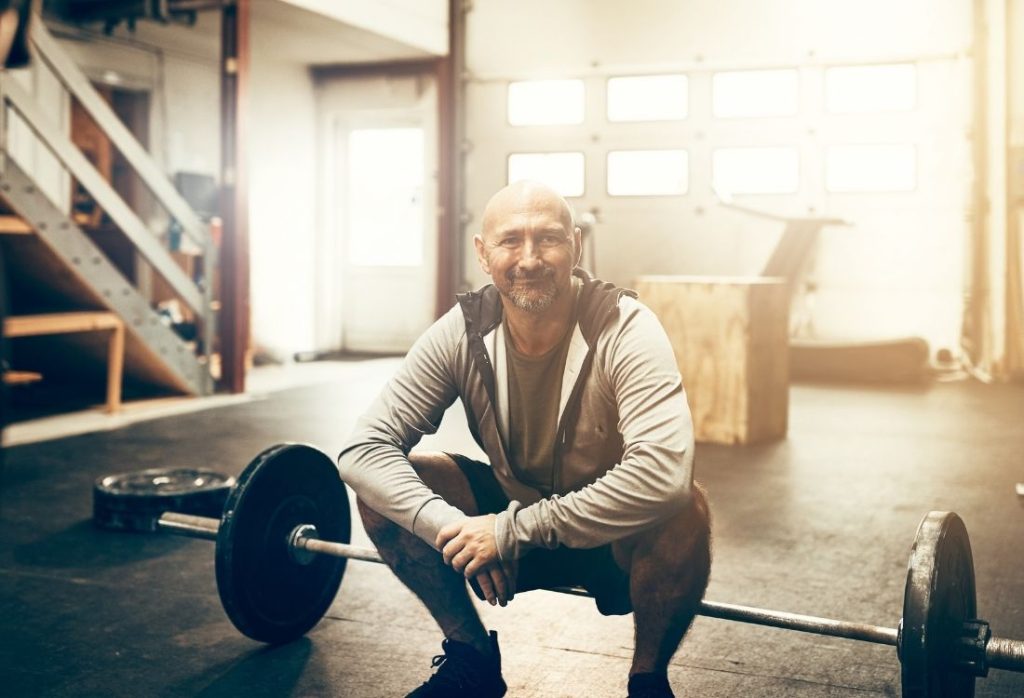
4.2 Heavy is a relative term, varying by individual and dependent on age, gender and base muscular strength. For instance at 78kg (running weight) and 63 years of age, my current 1 rep maximum for bench press is 68 kg. I can bench press 3 sets of 3 x 63kg as a challenging target. My current goal is to move towards 3 x 3 x 70kg over the next 9 months, though I’ve had that goal for a number of years. To a male in their late teens or early twenties it would be laughable to describe this as heavy.
4.3 Whilst many exercise physiologists are sceptical about weights for the upper body, I am convinced that they are beneficial to racing outcomes. In particular, upper body strength can be a real X factor in pulling out your absolute best performance in that final sprint to the tape. I certainly feel that it has enabled me to squeeze out that last bit of effort that I didn’t know I had during the final 100 to 200 metres of a gut-wrenching race at my weekly Newcastle Veterans competition. Goater & Melvin identify arm and upper body strength as important to running fast. Whilst recommending a range of strengthening regimes (including light weights) they state: ‘Your arms act as your accelerator pedal and your legs will never be able to go faster than your arms’. (22) I have found this to be so. Your legs definitely follow your arms. The importance of weight training the upper body and arms, including an insightful narrative of how the body works as a kinetic chain, is explained well in Rob Price’s publication Weight Training for Running, The Ultimate Guide (2012). (23) This is a great book that provides a comprehensive coverage of all aspects of weight training specific to runners, including tables to determine your 1 rep maximum lift.
- Building the Strength Program – Some Practical Considerations
In this section I list some essential elements to build your strength development program, with some observations from my personal experience. This list is not exhaustive. Naturally, the extent of your program is dependent upon your recent and past experience in strength development, and your state of health. It is always best to start conservatively especially if returning from a long break.
5.1 Safety is paramount. To lift heavy free weights we need to be careful, particularly as we approach 60 and beyond. We may have particular health risks that are more acute and need to be managed. Other risks include a higher propensity towards osteoporosis, tender joints, stiff tendons, and for some, muscles significantly affected by atrophy. (23) Medical clearance is recommended for those who have not used weights previously, or before increasing weight loads significantly.
Fee notes that moving to free weights should be done gradually from other forms of strength training, such as the use of machines. (24) For the mature runner it may be safer to use machines, rather than free weights, or mix up your strength-training regime with circuit training, power development exercises and dumb-bells. To ensure correct technique it may be preferable to lift weights in a controlled environment, at a gym under strict supervision. At the very least, if using free weights, always use a spotter.
Prudent advice for runners trying weights for the first time is contained in a Runners World booklet of 1973. Initially, runners are advised to stay very light for the first month and concentrate more on technique. Thereafter the advice is to ‘Increase the weight when the poundage becomes easy, generally going up no more than 5 pounds at a time. Five per cent every two weeks is a rough guideline to follow. Work hard but don’t strain.’(25) Another rule of thumb is to increase the number of reps before increasing the weight, (26) only bumping up the weight when eventually achieving 3 reps more in each set (X+3) than your starting point (X), and so it goes. When lifting heavier weights you may use an approach of X+1 or X+2 as the number of reps lifted will be low in real terms.
I have never been a gym junky, preferring to be a backyard operator from my parent’s old garage or in an outside sheltered part of my current home. I do my sessions in fresh air outdoors and free of crowds so I can concentrate. In attempting a particularly heavy session, for instance where I want to challenge
my 1 rep maximum lift, I always have my adult son act as a spotter. Outside of the act of lifting itself, I am also very careful in how I handle the weights.
I have used machines on occasion when travelling overseas and found them to be beneficial, but prefer the heavier resistance offered by free weights. I agree that machines would be a good way to transition to free weights.
I am not immune to the ravages of aging. I have some mild inflammation in my left shoulder, arthritis in all of my fingers, bursitis in my elbows and mild
osteoarthritis in my left hip. Coupled with a past diagnosis of significant bone loss in my right knee, this means that I am limited in my range of motion for some exercises. It also means that I manage any increase in weight load with a high degree of sensitivity to my body’s reaction. Everything is gradual, as it should be.
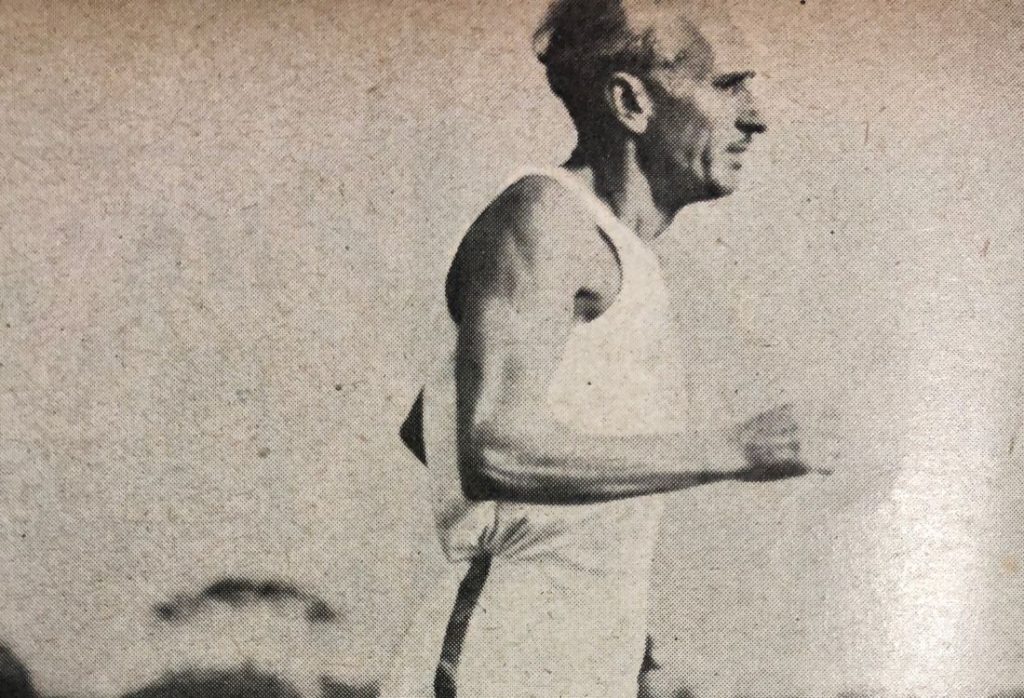 5.2 Schedule your weight training at least twice weekly, thrice if you can manage it. Whilst programs for younger runners tend to be seasonal, for the mature competitor the aging process dictates a more regular all year round conducting of strength work. Your tolerance for weight training can be greatly influenced by other physical activity you are doing outside of your normal exercise routine. Make sure you are rested to get the best out of your weight sessions.
5.2 Schedule your weight training at least twice weekly, thrice if you can manage it. Whilst programs for younger runners tend to be seasonal, for the mature competitor the aging process dictates a more regular all year round conducting of strength work. Your tolerance for weight training can be greatly influenced by other physical activity you are doing outside of your normal exercise routine. Make sure you are rested to get the best out of your weight sessions.
I have consistently averaged 2 weight sessions per week for many years, and found this is enough to support a program of progressive adaptation that assists my distance running performance. Whilst the Soft Quality Program enables appropriate spacing of sessions twice a week between higher intensity running sessions, I have been nimble in adjusting set days for weight training based on the need to be rested before lifting.
Much like Lydiard experimented to get his distance training formula right, I have enjoyed experimenting with the timing of my heavy weight sessions in a number of ways. I haven’t shied from testing myself in overload situations such as doing sessions 2 or 3 days in a row, doing a session same day immediately before or after a long run or some form of faster running (like fartlek or anaerobic work), or even having a session the day before a race. Readers would expect that doing a weight session after faster running efforts is quite difficult, and I can confirm this to be true. I also acknowledge that this is not a recommended approach; however, it was a level of experimentation I adopted with great care, listening to my body at all times.
Conventional wisdom is not to weight train on days of very long runs, or other hard running, upper body weights are to be done just prior to or after a regular run, leg and back work should follow or precede a run by several hours at least, and lifting work should be scheduled no sooner than 90 minutes after a meal and finish no later than 30-45 minutes before big meals. (27)
It may be surprising to some that I have found doing weights immediately before a tough running session (morning of or an hour before) or the day before a race to be quite beneficial. This may be because, as Livingstone has noted, the heavy weights are alactic sessions, with the effect of opening up the neural pathways. Drawing upon the fast twitch fibres has a positive flow on effect to my faster running? I’m surmising here, but I know how I feel, and I often feel great in my running in these situations. Admittedly, post these overload situations I sometimes need some extra easy running days to compensate for the effort.
5.3 Start your session with the heaviest weights then go down in weight. This was an epiphany for me during my late fifties after more closely reading
Livingstone’s (2009) views on weight training. (28) Initially, it may appear counter intuitive to those who typically start with lighter weights in a session, finishing with the heavier. However, it makes total sense because when doing the latter you end up attempting heavier weights when you are most fatigued. This undermines the best strength development effect your weight session can deliver if you were more rested for the heavier lifts.
As stated previously, this means a fewer number of reps within a set of heavy lifts. The beauty of heavy weights is you can achieve optimal benefit from a short sharp session. However, it is prudent to research and seek advice about the lift types that will meet your specific needs in muscular development. In my fifties I focused on curls, bench press and bent-over and vertical rows, using a full-length bar. However, into my sixties, whilst continuing with full bench presses (some may prefer push ups), I have gravitated to dumbbells for bicep curls and bent over rows as easier to manage modes of lifting. My weight session always includes bench presses. I mix up the combination of weights, rarely doing more than 3 sets of one type of lift at a particular load and never doing more than 4-5 reps in heavy bench presses (sometimes as low as 2 reps if close to my I rep maximum weight).
Whilst I have tended to concentrate on upper body development, I have toyed with dead lifts over the years and recognise the need to perform this lift as a more regular part of my strength program. This will assist in lower body strength development, as a highly effective complement to hill work. Cerutty in his classic book Be Fit! Or Be Damned (1967) is effusive in his recommendation of the deadlift, describing it as ‘The Basic and Best Exercise, and the most natural of all Exercises using apparatus’, dedicating one whole chapter to this lift. (29) I note with interest Livingstone’s comments that ‘..the deadlift can accomplish what we want for 90% of the skeletal muscle used in running! And it only needs a few very heavy repetitions, in a few sets, with lots of recovery in-between, to get maximal strength gains without unnecessary mass.’ (30) I now view my optimal program as bench presses, dead lifts, curls and rows (dumbbells).
In terms of recovery, I do not time my rest intervals between sets, only attempting another set when I feel psychologically and physically ready.
5.4 Ensure adequate warm up. This is very important both to prevent injury and to enable some neurological activation in preparation for heavy lifts. Typically, a warm up should centre on a joint-by-joint movement and mobility required for lifts, known as dynamic movement. This entails conducting full body movement with multiple muscle groups being emphasised at once. Duration only needs to be 5 to 10 minutes.
I have also found lifting a set of moderately heavy weights useful to prepare myself physically and psychologically for the heavier weights to come. As described by Price this is an exercise specific warm-up, a set of up to 10 reps at half your 1 rep max before each type of lift you attempt. (31) I do not do any cardio-based activities such as running or using exercise bikes. And I note that many experts in this field prefer dynamic movement to cardio.
Cooling down is not to be ignored, especially to ease potential soreness in the aftermath of a session. Stretching is a common cooling down activity, and can assist in improving your flexibility and range of motion. (32)
5.5 Consistency – Whilst younger runners would naturally prioritise their running ahead of strength work, I consider that a mature competitor does not have that luxury. From my perspective I give strength work a very high priority as a year round activity. If a mature runner ceases heavy weight training for several weeks they are likely to lose strength and muscle, especially if more senior eg seventies versus fifties. (33) I am even in the habit of increasing the number of weight sessions to 3 to 4 per week when injured and unable to run, as long as it is safe to do so. This keeps me active and in shape on some level, and is a useful outlet for pent up energy.
My weight sessions are supplemented with stretch band leg raisers, foam roller work on the legs and ball squat exercises (without weights) on a consistent but slightly irregular basis during the week. Basically, I sandwich these exercises between other commitments, often on the spur of the moment, as opportunities arise. The main thing is to get them done. There is no schedule involved.
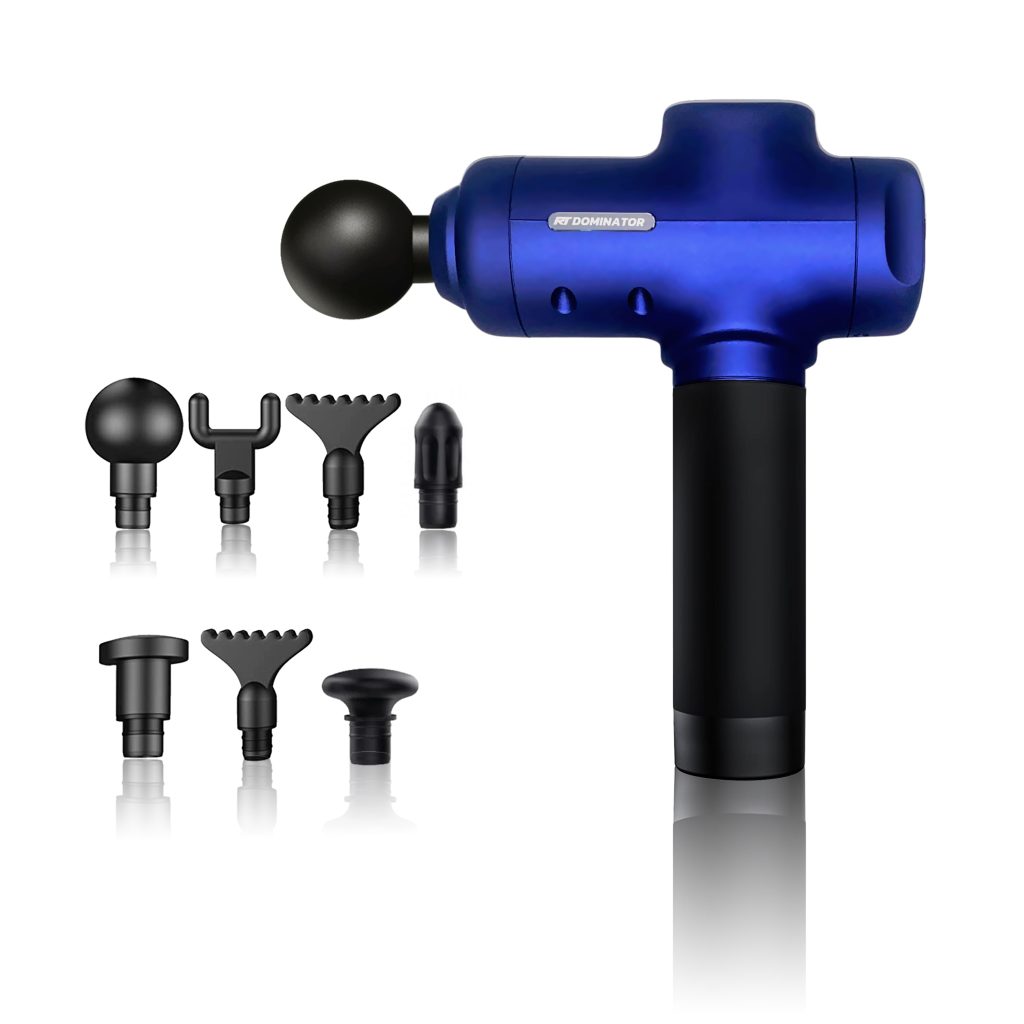
5.6 Antenna up for Excessive Soreness – As age affects how well the body builds muscle and rate of recovery, the mature runner needs to constantly review the best fit for scheduling sessions and the number of sessions to be conducted each week to reduce the likelihood overtraining.
As indicated elsewhere, micro damage to your muscles occurs every time you conduct a session and you are bound to experience some form of muscle soreness, especially when re-commencing a program after a long break, or if moving towards heavier weights. This is a natural part of your body adjusting to increased workloads.
However, if you have constantly tight and stiff muscles or always tired, you may need to reconsider the frequency of your sessions, the total load of your session, the nature of the lifts you are performing and/or the rate at which you are increasing the load. Of course the level and intensity of other physical activity (running and non-running related) can affect your capacity to lift and how you are feeling.
- Concluding Comments
I have provided some information about strength training as a touchstone for further investigation by the reader. Whilst I prefer to lift heavy free weights, and have limited my efforts primarily to upper body development, any form of strength training for the whole body is essential for the wellbeing and racing performance of mature distance runners.
My key messages are the need to perform strength training consistently, within your personal limitations, taking age, health and safety into account. And to integrate strength training within your existing program as an all year round component of your training.
This doesn’t mean that you can’t challenge yourself through a gradual adaptation process and the exercise of common sense in a lifelong approach to strength development. In the context of aging it is often about strength maintenance and/or delaying the onset of strength diminution.
Remember, just enough is good enough. It shouldn’t be excessive. Short and sharp is ideal as long as it is targeted appropriately to your particular strength development needs. I happen to think that use of heavy free weights gives the biggest bang for your buck for the mature elite distance runner. But then again, that’s just me, and despite what I have written I know that some will disagree.

References:
(1) Strength Training versus Power Training, Physopedia, accessed from internet 6 May 2022
(2) Bosse, C, Power Training vs Strength Training – what is the difference between Strength Training and Power Training?, Available from https://christianbosse.com/power-training-vs-strength-training-what-is-the-difference/ (last accessed 8 May 2022)
(3) Strength Training versus Power Training, 6 May 2022
(4) Beck, K, Running Strong, 2004, p83
(5) Fee, E, The Complete Guide to Running: How to become a Champion, from 9 to 90, 2005, p371
(6) Utzschneider, C, Mastering Running, 2014, p115
(7) Cerutty, P, Athletics How to Become a Champion, 1960 (7th impression 1968) p121
(8) Livingstone, K, Healthy Intelligent Training, 2009, p175
(9) Bosse, C, 8 May 2022
(10) Friel, J, Fast after 50, 2015, p170
(11) Beck, K, 2004, p110
(12) Fee, E, 2005, p374
(13) Ullyot, J, Women’s Running, World Publications, 1976, pp88-89
(14) The Female Runner, Runners World Booklet of the Month No. 34, 1974, pp18-19
(15) Utzschneider, C, 2014, p115
(16) Livingstone, K, 2009, pp179-181
(17) Utzschneider, C, 2014, pp46-49
(18) Utzschneider, C, 2014, p46
(19) Friel, J, 2015, pp123-124
(20) Friel, J, 2015, pp221-223
(21) When you need to fuel up after workouts for real muscle gains, Mens Health, accessed via internet 15 May 2022
(22) Goater, J and Melvin, D, The Art of Running Faster, 2012, p11, 142
(23) Price, R, Weight Training for Runners, The Ultimate Guide, 2012, p50
(24) Utzschneider, C, 2014, pp15-17
(25) Fee, E, 2005, p374
(26) Palmer, C, A Program for Runners, contained within Exercises for Runners, Runners World Booklet of the Month, No. 29, November 1973, pp54-55
(27) Palmer, C, 1973, p55
(28) Livingstone, K, 2009, p178
(29) Cerutty, P, Be Fit! Or be Damned, 1967, pp97-103
(30) Livingstone, K, 2009, pp173-174
(31) Price, R, 2012, p21
(32) Price, R, 2012, p22
(33) Friel, J, 2015, p124






